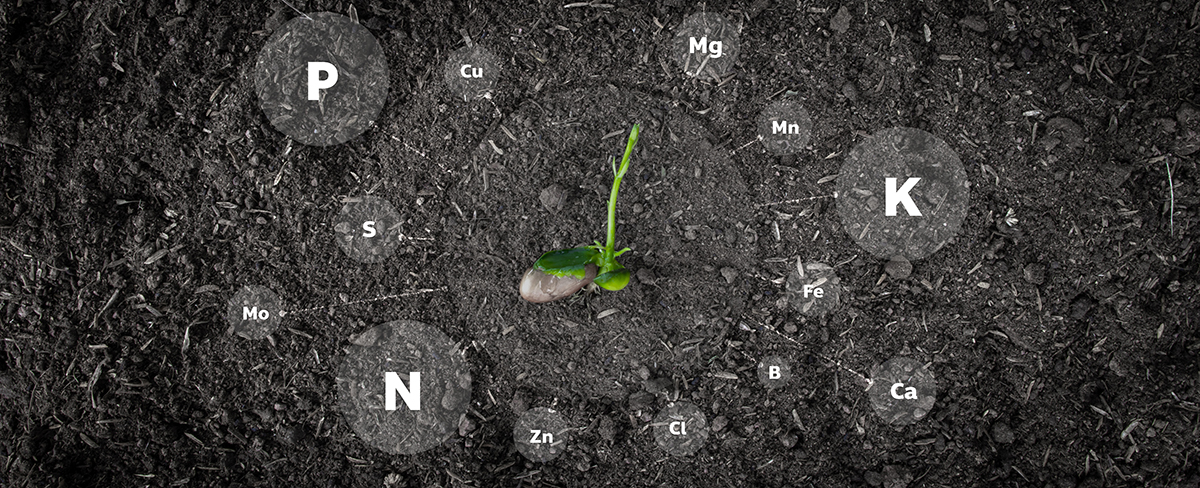Understanding soil nutrient availability

Soil is naturally a rich resource of all the nutrients the plant/tree needs. Several soil properties impact the ability of a plant/tree to obtain these nutrients from the soil for growth such as soil type, texture, moisture, pH, soil depth, etc. Nutrient availability depends upon the amount and solubility of nutrients in the soil dictated by the soil properties. Some nutrients, such as nitrate-nitrogen (NO3–N), magnesium (Mg), sulfur (S), boron (B), calcium (Ca), and potassium (K), are mobile in the moist soil and move towards the plant roots with water via a process called “mass flow.” Other nutrients, mostly micronutrients such as iron (Fe), zinc (Zn), copper (Cu), and manganese (Mn), are immobile in the soil.
The immobility of micronutrients within the soil makes their availability dependent on the root health and distribution (roots growing closer to the micronutrients). Secondly, any condition that restricts root growth, such as soil compaction, waterlogging, or the presence of toxic ions (e.g., sodium and chloride), negatively impacts the availability of these immobile micronutrients. Thirdly, soil pH strongly influences the solubility of soil micronutrients, and strongly acidic or alkaline soil pH can cause their deficiency or toxicity.
Depending upon the above factors, different plant/tree species have relative effectiveness in accessing nutrients from the soil and exhibiting nutrient deficiency or toxicity symptoms. Plants could be deficient in one or more nutrients due to the following conditions:
Unfavorable soil conditions increase difficulty for plant nutrient uptake. Soil pH significantly impacts nutrient availability, such as high soil pH (>7.5), limiting the solubility of Zn, Cu, Mn, and Fe.
Soil temperature, water availability, aeration, and the existence of a hard pan can limit plant/tree root growth and impact nutrient uptake.
An absolute deficiency of an element in the soil is rare but may occur in highly sandy soils and can only be rectified by adding fertilizers.
Unfavorable soil conditions
Soil nutrient tests (soluble Zn, soluble Fe, and DTPA Extract) are essential for the prediction of nutrient concentrations, but the availability of micronutrients (specifically Zn, Fe, Cu, and Mn) to plants can be limited by unfavorable soil conditions. During such conditions, nutrient supplementation with fertilizers may not be valuable, but correcting the primary soil conditions will help improve the symptoms. To determine whether the deficiency is due to the absence of nutrients or soil conditions, additional information from soil sampling such as macronutrient availability, soil pH, and assessment of favorable or adverse soil conditions becomes helpful. For example, soil pH plays a major role in micronutrient (Zn, Mn, Cu, and Fe) availability in neutral to alkaline Californian soils (Figure 1). Specifically, high soil pH and high organic matter can make Zn immobile and unavailable for plant uptake. Therefore, understanding the mechanisms around soil properties is essential.

Soil nutrient tests are informative, but the uncertainties can be associated with extreme difficulty in obtaining representative soil sampling due to extensive tree root systems and vertical heterogeneity of sampled soil. In many cases, nutrients are available in soil but are subject to plant uptake unavailability due to unfavorable soil conditions, resulting in deficiency symptoms in plants.
Mobility within the plant
Management of nutrients requires consideration of both mobility in the soil and plants and a history of deficiency symptoms. Plants/trees translocate the nutrients to shoots, roots, and fruits upon absorption. Some of the nutrients, such as N, P, K, S, Cl, and B, can move within the plant's xylem and phloem and are called mobile nutrients, whereas the others, such as Fe, Mn, Cu, and Ca, are immobile and can only move within the xylem along with water through transpiration stream. Deficiency symptoms of immobile nutrients appear on the young leaves first as they cannot be translocated from the older leaves where there are enough of them, whereas, for the mobile nutrients within the plant, the deficiency symptoms first appear on older leaves as the nutrients get translocated to the younger leaves when there is need for the new growth. Therefore, patterns of deficiency symptoms exhibited by trees/plants could also help detect the deficiency of nutrients.
Therefore, soil analysis is helpful once the deficiency or excess is identified through foliar symptom development or tissue testing to understand the conditions better. History of deficiency symptoms, tissue testing, soil pH, and experience of soil conditions are equally crucial for understanding soil nutrient availability and estimating fertilizer needs.
References
Truog, E. (1948). Lime in relation to availability of plant nutrients. Soil Science, 65(1), 1-8.
Text © . The authors. CC BY-NC-ND 4.0. Except where otherwise noted, images are subject to copyright. Any reuse without express permission from the copyright owner is prohibited.









